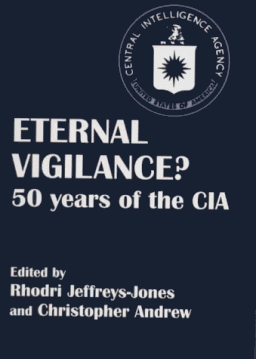edited by Rhodri Jeffreys-Jones and Christopher Andrew
Frank Cass, London/Portland, Oregon, 1997, £15.00 pb
There are two kinds of books about the CIA: there are those like William Blum’s, advertised in this issue, which see the CIA simply as part of the US post-war empire, the sharp end of imperial enforcement, somewhere between the IMF and the 6th Fleet in the process of ripping-off the Third World; and there are the academic studies, like this one, in which the words ‘US empire’ would never appear, and in which you will find almost none of the information contained in Blum. Where Blum is concerned with the covert operations of the CIA, the academic student shies away from that – it’s bad for careers – and concentrates on the CIA’s intelligence-gathering activities. There is, of course, nothing in here on subjects like the Agency’s role in the death squad regimes of Central America in the last twenty years, or its role in the international drug traffic. I’m with Blum: like him I tend to follow Prouty and view the intelligence-gathering end of the CIA’s role as virtually a cover story for the covert operations; but that doesn’t mean the academic end of things is uninteresting.
This collection contains three essays of note. The first is Bob de Graff and Cees Wiebes’ study of the CIA and the Dutch Intelligence Service, which is the first of its kind that I can think of; and is, presumably, a template for the relationship between the CIA and the intelligence services of other small countries unfortunate enough to have come within the CIA’s sphere of influence. (It is worth remembering that in 1965, in its imperial pomp, the CIA came to London and proposed incorporating MI5 into the Agency’s London station….)
The second is Helen Laville’s study of the CIA’s funding of one of the US women’s group, the Committee of Correspondence, in the 1950s and 60s. This essays raises all the issues of cooption and corruption which are discussed in the study of the International Rescue Committee reviewed below. We may yet discover that, as Daniel Brandt suspects, the CIA played a similar role in the 1970s with some of the more radical US feminist groups.
The third is Lawrence Freedman’s discussion of the politicisation of the intelligence estimates process. Freedman’s book on this, US Intelligence and the Soviet Strategic Threat (Macmillan, 1986) is a fascinating piece of work, and in this essay Freedman revisits the section of the book leading up to the so-called Team B exercise which provided the intellectual basis for the massive US rearmament of the 1980s.
There are chapters on the CIA’s science work and economic intelligence – even one on the CIA’s study of itself. In the essay on the CIA and science authors Doel and Needell skirt the Agency’s part in MKULTRA and similar projects and timidly conclude,
‘the ethical lapses of CIA medical specialists in ‘Artichoke’ and ‘MKULTRA’ mind-control experiments ranked among the Agency’s most troubling violations of national trust.’
‘Ethical lapses’, even.
Co-editor Andrew concludes the collection with a survey of research developing in these fields now that the Cold War is over, and includes his now customary warning of the dangers of conspiracy theorising – citing James Angleton as an example of what can happen: ‘Once contracted, conspiracy theory is an incurable condition.’ As usual, the irony of that comment coming at the end of a study of one of the largest conspiracies ever organised, escapes him.
